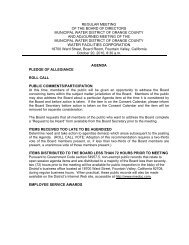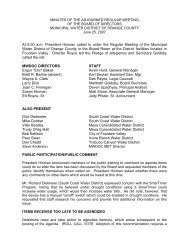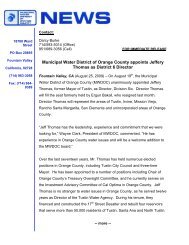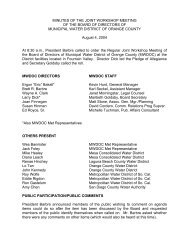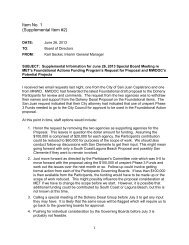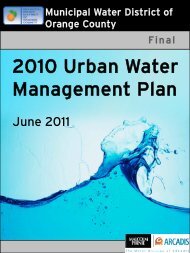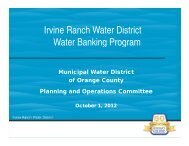Phase 3 - Extended Pumping and Pilot Plant Testing Feasibility ...
Phase 3 - Extended Pumping and Pilot Plant Testing Feasibility ...
Phase 3 - Extended Pumping and Pilot Plant Testing Feasibility ...
You also want an ePaper? Increase the reach of your titles
YUMPU automatically turns print PDFs into web optimized ePapers that Google loves.
Dana Point Ocean Desalination Project: <strong>Phase</strong> 3 - <strong>Extended</strong> <strong>Pumping</strong> <strong>and</strong><br />
<strong>Pilot</strong> <strong>Plant</strong> <strong>Testing</strong> <strong>Feasibility</strong> Investigation<br />
By Richard Bell, MWDOC Principal Engineer<br />
Since 2002, the Municipal Water District of Orange County (MWDOC) has been<br />
investigating the technical, environmental, economic, <strong>and</strong> institutional feasibility<br />
for the planned Dana Point Ocean Desalination Project. This project is part of an<br />
overall water supply reliability program for Orange County <strong>and</strong> the region. It is<br />
part of Metropolitan Water District of Southern California’s Integrated Resources<br />
Plan <strong>and</strong> Seawater Desalination Program.<br />
The proposed project location, which is adjacent to San Juan Creek, was<br />
determined to be the best desalination site in south Orange County. An ocean<br />
desalination plant will enhance water supply <strong>and</strong> system reliability to an area that<br />
is over 95% dependent on imported water supply. One of the major project<br />
challenges is to find an appropriate, cost-effective, <strong>and</strong> environmentally<br />
acceptable means to supply the desalination plant with ocean water.<br />
Over the past four years, MWDOC has been investigating the use of state-of-theart<br />
slant beach well technology for production of ocean water from s<strong>and</strong>s <strong>and</strong><br />
gravels that underlie the ocean in this location. The offshore marine aquifer was<br />
formed by processes of erosion <strong>and</strong> sedimentation within the continental shelf<br />
during the ice ages when sea level was over 350 feet lower than today. The<br />
hydrogeology work conducted to date indicates that the aquifer in this location is<br />
highly permeable <strong>and</strong> extends well out under the ocean. Producing ocean water<br />
from the marine aquifer would completely avoid entrainment <strong>and</strong> impingement<br />
impacts that occur from conventional intakes.<br />
Since the entire width of the s<strong>and</strong> <strong>and</strong> gravel deposits underlying San Juan<br />
Creek is fully located within Doheny State Beach, the Test Slant Well was sited<br />
near the Lifeguard Tower just north of San Juan Creek. It was successfully<br />
constructed in spring 2006. A short-term aquifer <strong>and</strong> water quality pumping test<br />
was conducted, indicating a productive aquifer. Due to the very wet 2004/05<br />
water year, the saltwater interface in the marine aquifer was located about 1,100<br />
feet offshore at the time of the initial short-term testing work. An extended<br />
pumping test is required to pull in ocean water <strong>and</strong> perform various more<br />
intensive water quality <strong>and</strong> pilot process treatment testing.<br />
The Test Slant Well is the first slant beach well constructed under the ocean for<br />
ocean water desalination feed water supply. Advanced dual rotary water well<br />
drilling technology was utilized in constructing the Test Slant Well. For this<br />
location, this technology was found to have the least environmental impact on the<br />
ocean compared to other subsurface technologies while providing very good<br />
yield <strong>and</strong> excellent feed water quality.<br />
This approach has been well received by the California Coastal Commission <strong>and</strong><br />
the environmental community. Where feasible, subsurface intakes can offer cost<br />
1
savings <strong>and</strong> environmental benefits compared to conventional open intake<br />
systems. Since the fall of 2004, MWDOC’s <strong>Phase</strong> 1 <strong>and</strong> 2 feasibility<br />
investigations received State Parks’ approval <strong>and</strong> support, a State L<strong>and</strong>s<br />
Commission Lease, a Regional Board NPDES Permit <strong>and</strong> 401 Certification, a<br />
USACOE Nationwide Permit <strong>and</strong> Jurisdiction Determination, <strong>and</strong> California<br />
Coastal Commission Coastal Development Permits.<br />
To date, MWDOC has received letters of support from the Surfrider Foundation<br />
<strong>and</strong> Orange County Coastkeeper for investigating this approach to providing<br />
feedwater supply for this project.<br />
In support of this investigation work, grants have been received from the U.S.<br />
Environmental Protection Agency, U.S. Bureau of Reclamation, California<br />
Department of Water Resources, <strong>and</strong> local <strong>and</strong> regional water agencies.<br />
<strong>Phase</strong> 3 <strong>Extended</strong> <strong>Pumping</strong> <strong>and</strong> <strong>Pilot</strong> <strong>Plant</strong> <strong>Testing</strong><br />
Over the last several months, MWDOC has been working with several agencies<br />
in south Orange County on forming a project participation committee to direct the<br />
<strong>Phase</strong> 3 <strong>Extended</strong> <strong>Pumping</strong> <strong>and</strong> <strong>Pilot</strong> <strong>Plant</strong> <strong>Testing</strong> work, which will complete the<br />
feasibility investigation work previously undertaken in <strong>Phase</strong> 1 <strong>and</strong> 2. To date,<br />
South Coast Water District, Laguna Beach County Water District, <strong>and</strong> Moulton<br />
Niguel Water District have agreed to participate in <strong>Phase</strong> 3. Other agencies are<br />
also considering participation.<br />
Key elements of the <strong>Phase</strong> 3 investigation include confirmation of filtration<br />
capability of the aquifer <strong>and</strong> well, evaluation of biofouling <strong>and</strong> mineral scaling<br />
potential <strong>and</strong> control options, testing of c<strong>and</strong>idate reverse osmosis membranes,<br />
completion of the hydrogeology investigation work, validation/refinement of the<br />
groundwater model, <strong>and</strong> updating the overall project engineering feasibility study.<br />
<strong>Phase</strong> 3 <strong>Extended</strong> <strong>Pumping</strong> <strong>and</strong> <strong>Pilot</strong> <strong>Plant</strong> <strong>Testing</strong> will require up to two years of<br />
continuous pumping to pull in ocean water <strong>and</strong> to conduct the necessary water<br />
quality testing <strong>and</strong> treatment process studies. The <strong>Phase</strong> 3 work includes<br />
installation of a submersible pump in the Test Slant Well, a fully buried wellhead,<br />
a short 12-inch diameter pipeline, a mobile test facility, <strong>and</strong> a discharge pipe <strong>and</strong><br />
diffuser assembly. Currently discussions are being held with State Parks to<br />
permit the temporary mobile test facility to be situated adjacent to the rear<br />
parking lot near San Juan Creek. The produced <strong>and</strong> aerated Test Slant Well<br />
water is planned to be discharged to ocean at the surf zone in a safe area<br />
adjacent to the west San Juan Creek concrete levee structure (groin).<br />
Discussions are now underway with the permitting agencies, <strong>and</strong> environmental<br />
documentation work has been initiated.<br />
The purpose of the membrane pilot testing is to evaluate whether any special<br />
pretreatment would be required to control biofouling <strong>and</strong> mineral scaling,<br />
including low levels of dissolved iron <strong>and</strong> manganese that are anticipated to be<br />
present in the water. The extended pumping data would then be used to validate<br />
2
<strong>and</strong> refine the groundwater model. The model would then be used to finalize the<br />
recommended project capacity <strong>and</strong> to assess groundwater levels <strong>and</strong> related<br />
effects under a range of upstream pumping patterns <strong>and</strong> groundwater level<br />
conditions.<br />
The <strong>Phase</strong> 3 schedule is looking to obtain all permits <strong>and</strong> approvals later this fall<br />
in order to allow the installation of the <strong>Phase</strong> 3 test facilities by mid-May 2009.<br />
All construction work on the State Beach needs to be completed prior to the busy<br />
summer beach season.<br />
Exhibit 1. <strong>Phase</strong> 3 <strong>Extended</strong> <strong>Pumping</strong> <strong>and</strong> <strong>Pilot</strong> <strong>Plant</strong> <strong>Testing</strong> Facilities, Doheny<br />
State Beach<br />
<strong>Feasibility</strong> Investigation, Dana Point Ocean Desalination Project<br />
3



